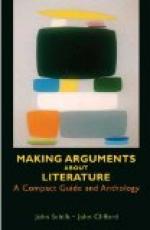One thing, however, it is almost always wise to do; indeed, one would not go far wrong in prescribing it as a general rule: that is, to state with almost bald explicitness just how many main issues there are, and what they are. In writing an argument it is always safe to assume that most of your readers will be careless readers. Few people have the gift of reading closely and accurately, and of carrying what they have read with any distinctness. Therefore make it easy for your readers to pick up and to carry your points. If you tell them that you are going to make three points or five, they are much more likely to remember those three or five points than if they have to pick them out for themselves as they go along. Huxley, perhaps the ablest writer of scientific argument in the language, constantly practiced this device. In his great argument on evolution, he says (see p. 235): “So far as I know, there are only three hypotheses which ever have been entertained, or which well can be entertained, respecting the past history of nature”; and then, as will be seen, he takes up each in turn, with the numbering “first,” “second,” and “third.” In the same way in his essay “The Physical Basis of Life” he says, not far from the beginning, “I propose to demonstrate to you that, notwithstanding these apparent difficulties, a threefold unity—namely, a unity of power or faculty, a unity of form, and a unity of substantial composition—does pervade the whole living world.” Burke, in his great speech “On Conciliation with America,” said, “The capital leading questions on which you must this day decide are two: first, whether you ought to concede; and secondly, what your concession ought to be.”
It is hardly too much to say that those writers whose sense of style is most developed are most likely to state the issues with the baldest and most direct precision.
The statement of the issues will bring out the importance of closely limiting the number of main issues. There are few subjects of argument which do not conceivably touch the interests and beliefs of their audiences in many directions; but out of these aspects some obviously count far more than others. If in your introduction you try to state all these issues, small and great, you will surely leave confusion behind you. Very few people are capable of carrying more than three or four issues distinctly enough to affect their judgment of the whole case; and even of these some will not take the trouble to do so. If you can simmer down the case to one or two or three critical points, you are making a good start toward winning over the minds of your readers.
A good statement of the history of the case is apt to be a useful and valuable part of an introduction, especially for arguments dealing with public policies. If you remind readers of what the facts have been, you can more easily make clear to them the present situation from which you make your start. An argument for raising or lowering the tariff on some article would be apt to recount the history of the tariff so far as it concerned that article, and the progress in importing it and manufacturing it within the country. In writing out the argument from the brief on page 90 one would almost inevitably include the recent history of the city government.




